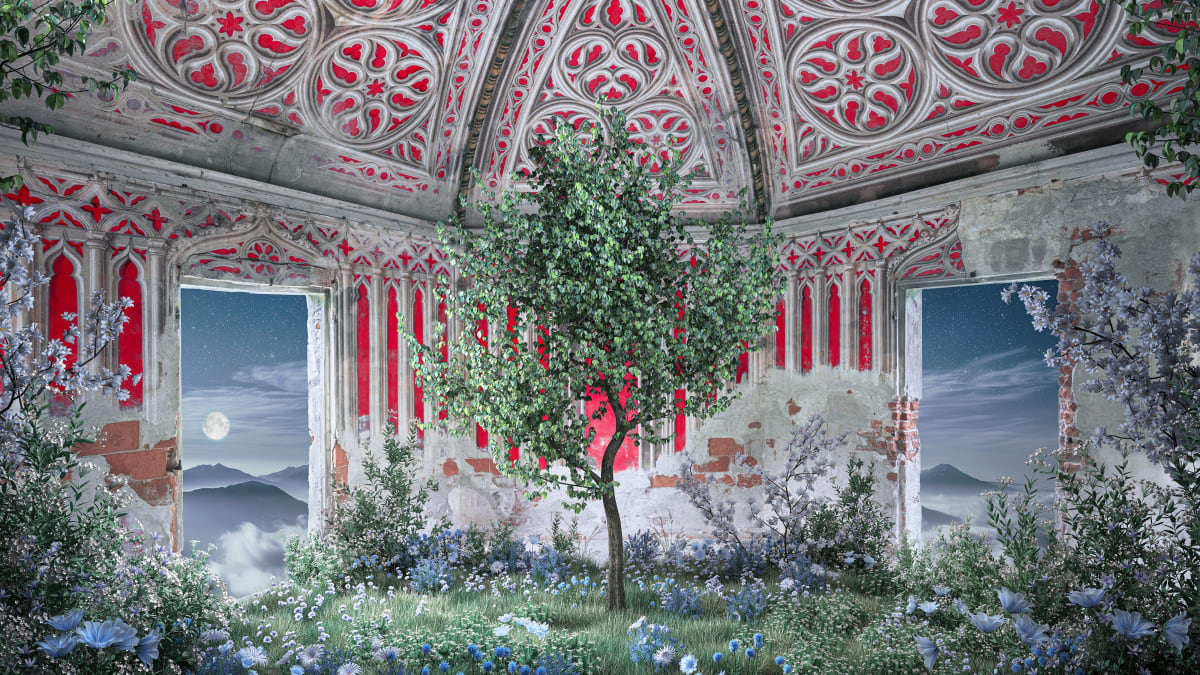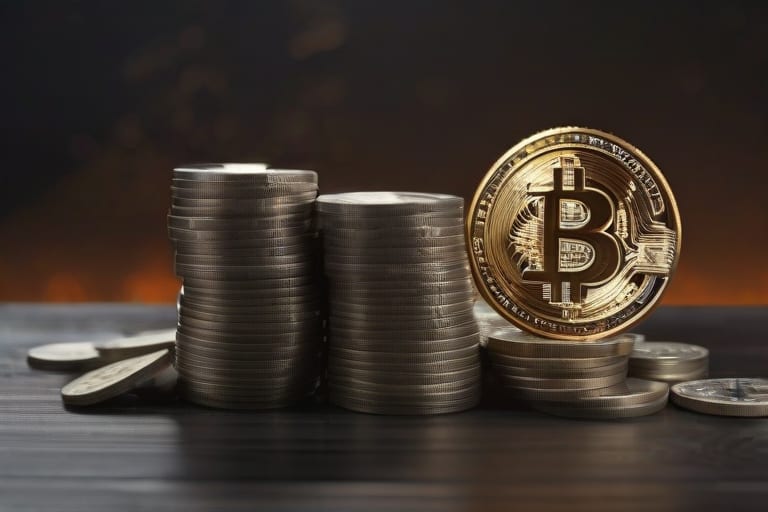Ryan Koopmans – Interview Related "origin" inscription work


In the evolving contemporary art landscape, few artists capture the essence of change and permanence as powerfully as Ryan Koopmans and Alice Wexell. Their artwork bridges the gap between the natural world and urban decay. They delve into the heart of abandoned places and transform them into digital masterpieces that question the boundaries between reality and digital artificiality. Together, they explore the concepts of heritage and preservation in the digital age by recording their work on Bitcoin’s immutable ledger. Their latest work ‘The Origin’ demonstrates their innovative approach to digital art. Combining photography, digital manipulation, and Bitcoin ordinal technology to create a dynamic on-chain artwork that reflects the passage of time in the ruins of an Italian building. As pioneers in the field, Koopmans and Wexell challenge us to rethink the value and permanence of art in the digital age and invite us to question our notions of time, memory, and legacy.
Steven Reiss: Many people will know you from your work with Alice Wexell on the series ‘The Wild Within’. Perhaps you could briefly explain how you came up with the idea of using abandoned buildings to create works of art.
Ryan Koopmans: wild inside A series of digital artworks that breathe new life into abandoned buildings from a bygone era. Having worked as a documentary photographer for 15 years, I have felt the urge to create work that involves imaginative interventions rather than purely as a ‘witness to the real world’.
After photographing abandoned buildings in Georgia, we realized there was more conceptual work that could be done to enhance the images and truly highlight the emotions and atmosphere we experienced while exploring these crumbling ruins.
As a result, ‘The Wild Within’, a project started by my wife Alice Wexell and I, was created by photographing actual physical spaces in countries that have experienced dramatic change, including Georgia, Lebanon, Armenia, Italy, and Poland, and then creating conceptual art. Work.
Upon returning, we digitally introduce plants and modify the structure and lighting with the intention of revitalizing the empty space, essentially bringing the room back to life.
The result is a surreal clash between past and future, natural and artificial, physical and digital, reality and imagination.
Additionally, many of the buildings that appear in the movie are wild inside These buildings have been demolished in recent years or continue to deteriorate, emphasizing the theme of time passing in cycles of growth and decline.
To commemorate the day the first piece of ‘The Wild Within’ was minted on Ethereum, we decided to engrave the piece in satoshi mined (Ryan stands for ‘The Origin’, SR) on March 24, 2021 .
SR: What is the appeal and how do you proceed? When is a scene correct and how do you process the image?
RK: We have long been inspired to travel to remote areas and discover places that have not yet been extensively photographed.
Particularly fascinating to us are buildings that are abandoned and left to deteriorate without intervention. They act as time capsules, especially rooms that have been sealed off from outside visitors for decades.
It takes a long time to research these structures, discover them, photograph them, and create works of art. So we’re very selective about what we actually release into the world. Sometimes when we photograph a particular room, we get a feeling in our hearts that this will be the image that belongs in the project.
Exploring and carefully constructing images into works of art activates all of our interests in architecture, nature, creative expression, and the human condition.
The structures we want to build on are inherently rare, as many have deteriorated or have already disappeared since they were first discovered.
In many cases, due to fire, demolition, looting or natural factors, buildings no longer exist in their former form as the world rapidly modernizes.
Importantly, the work of art itself, as well as its subject matter, are immortalized and preserved on the blockchain, functioning as an artistic and interpretive act of architectural preservation.
SR: Why did you choose this particular location for ‘The Origin’?
RK: It was important to us to enter the world of Bitcoin inscriptions with a concept that not only embraces the potential of the technology, but is also faithful to the unique themes of our work.
Considering that the theme of time is a recurring element, we collaborated with the Inscribing Atlantis team to create a dynamic piece based on time. The piece synchronizes with the Bitcoin clock to seamlessly switch between day and night modes.
To achieve this it was important to use an interior with large windows that connect to the external environment. Located in the woods on the outskirts of a small town in northern Italy, this extraordinary architectural space occupies the top floor of a tower. Access to it involved climbing up to a window and carefully navigating along a precariously suspended wooden floor.
The unique patterns on the walls and circular shapes within the space provided an ideal environment for composing this work. Because it felt like a nucleus or an encapsulated hub for a big idea.
SR: In your ‘The Origin’ presentation, you interestingly described both abandoned buildings and digital artefacts inscribed on Bitcoin as anthropological signs. Can you elaborate on how this concept informs your work, especially in terms of contributing to the broader discourse on digital heritage and cultural preservation? Also, how do you reconcile the juxtaposition between the physical decay of buildings and the enduring nature of Bitcoin in your artistic process?
RK: Architecture serves as an anthropological marker of the landscape, albeit a temporary one. Within the structure itself, you can discover traces of the passage of time and the traces left by humans, its inhabitants, vandals, and forces of nature. The concept of impermanence and the ultimate disappearance of these representations inspires the idea of taking photographs, creatively intervening, and then preserving the visual elements on the blockchain.
Exploring these buildings often reveals interesting artifacts, evoking a sense of discovery that evokes the feeling of discovering a forgotten era.
Inscriptions for ordinal numbers are also digital artifacts, although more permanent, scattered throughout the network. It’s interesting to look back at the evolution of these signs over time, varying in quality and intent but reflecting the cultural context in which they were created and distinct moments in time.
Creating digital works of art is a form of preserving these experiences and ideas, but recording them on a secure, immutable blockchain provides an even higher level of permanence.
Our goal is not to create historically accurate representations or documentation of architecture. Instead, we aim to preserve our interpretation of this ephemeral subject by creating artwork that depicts decaying buildings in an imaginatively overgrown state.
Ultimately, our goal is to ensure that artwork outlives us, and leveraging this technology can provide a solid medium to protect the digital legacy of artwork.
SR: How do you see the role of digital art in the future, given that your work will outlive you? Do you think that digital artwork can achieve the same emotional and cultural meaning as a physical piece of art if the physical impact is completely removed?
RK: Of course. Digital works are being created at a time when future display methods have not yet been fully implemented. We don’t yet know what kinds of frictionless screens or immersive perspectives will be integrated into our everyday visual environments.
In the current approach to displaying digital art, the appeal of printing it or displaying it on a wall screen lies in the residual value attached to the tangible nature of the art. However, these methods are not ideal for showcasing the full potential of digital artworks, which need not directly ‘compete’ with traditional art in the realm of physical display.
As the tools for art creation and distribution become more widely accessible, digital art production will surge like never before. In my opinion, it is inevitable that certain digital works will attain the same status as the world’s most valuable physical assets.
I look forward to a continued shift towards a more digital future, especially with the emergence of younger generations who are already digitally savvy.
Preferences for collecting physical or digital works may fluctuate over time, but as cultural tastes often do, digital works are undoubtedly evolving toward achieving similar cultural significance without the need for physical impact.
SR: For many artists, Bitcoin as an art medium is still new. Why did you decide to publish your work about Bitcoin in the first place? And what was special about it? Have there been any challenges or new opportunities?
RK: Being innovative and embracing new technologies is a core value of The Wild Within project. We love the crossover between traditional and timeless art, while incorporating innovative techniques in many instances. As our first collaborator with AI artist Botto, we have teamed up with Botto DAO to create a unique collaborative piece. We also created an immersive 3D space for another of our works, allowing viewers to virtually ‘enter’ the painting leading to a lush room filled with animation.
Although Ethereum has fewer file size limitations when mining than Bitcoin, the development of recursion has been a game-changer for us by allowing us to create larger works of art with multiple inscriptions.
Each blockchain provides a cost-benefit analysis that includes both trade-offs and benefits when releasing a work of art. Ordinal numbers functioning as digital artifacts evoke the feeling of preserving these aging buildings and artworks on the blockchain.
Reaching new audiences is essential to being an artist, and the Bitcoin art community has been welcoming, supportive, and passionate.
Plus, having the opportunity to work with the talented developers at Inscribing Atlantis meant we could create artwork that was tailored and tailored to our artistic vision.
SR: The name ‘The Origin’ suggests there is more to come. Can you open up about that yet?
The ability to create source structures that organize their existence in ordinal numbers is truly exciting. The provenance structure of ancestors, parents, and children is very attractive because it lays the foundation for future growth. We’ve left open the possibility of adding another 1/1 piece under the parent entry in the future, and the structure allows for the possibility of releasing editions under that category.
What we’ll launch next and when hasn’t been decided yet, but one thing’s for sure: now is the right time to leave your mark on Bitcoin. However, it must be done with respect, cultural understanding, creative intention and meaning, because once a result is achieved there is no going back!
This is a guest post by Steven Reiss interviewing Ryan Koopmans. The opinions expressed are solely personal and do not necessarily reflect the opinions of BTC Inc or Bitcoin Magazine.


